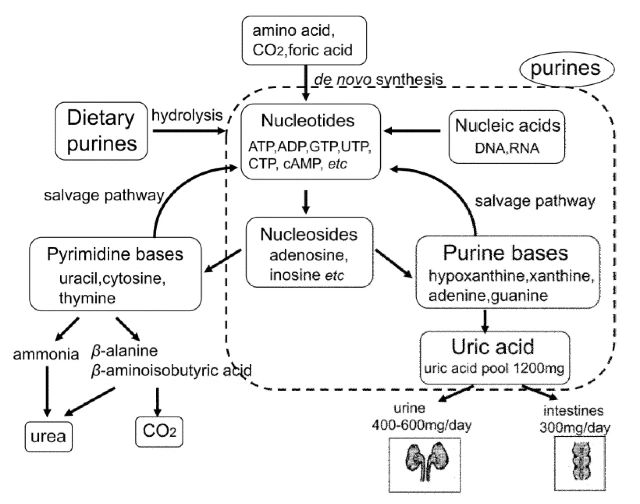This is my review of a study of purines in food. In which I will explain the key points for gout dieters. So this is for people who are concerned about how food affects uric acid. Because it helps you discuss your gout diet concerns with health professionals. In the hope that you can support your doctor’s treatment plan with better food choices.
Citation for Purine Types and Uric Acid
This is a GoutPal review of:
Kaneko, Kiyoko, Yasuo Aoyagi, Tomoko Fukuuchi, Katsunori Inazawa, and Noriko Yamaoka. “Total purine and purine base content of common foodstuffs for facilitating nutritional therapy for gout and hyperuricemia.” Biological and Pharmaceutical Bulletin (2014): b13-00967.
At the time of writing, this study has been cited by 83 other studies.
Purine Types and Uric Acid Purpose
The purpose of this study is to provide reference lists of the purine content of common Japanese foods. Including values for each of the 4 main purine bases: adenine, guanine, hypoxanthine, and xanthine.
we add our latest data and summarize the amount of total purines as well as the four individual purine bases in various foodstuffs […] We also calculated the ratio of adenine, guanine or hypoxanthine to the total purine in these foods, and discussed the association with the risk of gout.
Jargon-free Abstract
In the jargon-free abstract I present the key points of the original abstract. Replacing jargon with terms more familiar to unqualified people interested in gout. However, this topic is about one of the key jargon words – purine. So I have to include 4 different types of purine: adenine, guanine, hypoxanthine, and xanthine. Note that my selection of other jargon terms might not match yours. So please ask in the feedback form near the end of the page if you need clarification.
- Background / Introduction
- Our bodies use purines to create uric acid which is healthy until levels rise too high. As high uric acid causes gout, Japan recommends purine intake below 400 mg per day.
- Methods
- The purine content of 270 foods was measured. Then analyzed into food groups according to hypoxanthine content.
- Results / Findings
- Foods with high hypoxanthine content raise uric acid more than other purines.
Original Abstract
Purines are natural substances found in all of the body’s cells and in virtually all foods. In humans, purines are metabolized to uric acid, which serves as an antioxidant and helps to prevent damage caused by active oxygen species. A continuous supply of uric acid is important for protecting human blood vessels. However, frequent and high intake of purine-rich foods reportedly enhances serum uric acid levels, which results in gout and could be a risk factor for cardiovascular disease, kidney disease, and metabolic syndrome. In Japan, the daily intake of dietary purines is recommended to be less than 400 mg to prevent gout and hyperuricemia. We have established an HPLC method for purine analysis and determined purines in a total of 270 foodstuffs. A relatively small number of foods contained concentrated amounts of purines. For the most part, purine-rich foods are also energy-rich foods, and include animal meats, fish meats, organs such as the liver and fish milt, and yeast. When the ratio of the four purine bases (adenine, guanine, hypoxanthine, and xanthine) was compared, two groups of foods were identified: one that contained mainly adenine and guanine and one that contained mainly hypoxanthine. For patients with gout and hyperuricemia, the amount of total purines and the types of purines consumed, particularly hypoxanthine, are important considerations. In this context, the data from our analysis provide a purine content reference, and thereby clinicians and patients could utilize that reference in nutritional therapy for gout and hyperuricemia.
Purine Types and Uric Acid Conclusions
Key points are:
- Consider total purine intake.
- Consider different types of purines.
- Foods with purines over 200 mg per 100 g are risky for high uric acid.
- Moderate consumption of metallic fish is good for gout and heart disease.
- High consumption of low purine foods is strongly recommended.
- High purine foods should be a small part of balanced healthy eating patterns.
The first [important point] is the amount of total purines in the food and the second is what types of purine bases are included.
The consumption of foods that contain >200 mg/100 g of purines, especially with a high ratio of hypoxanthine, is considered to be a high risk for hyperuricemia. […] moderate consumption
of metallic fish that contain a considerable amount of guanine is recommended not only for the management of gout and hyperuricemia but also for decreasing cardiovascular disease risk. High intake of low-purine foodstuffs, such as dairy products, cereals, beans, vegetables, mushrooms, and soybean products, is strongly recommended. […] Purine-rich food should be eaten in moderation. Good dietary habits with a good balance of nutrients are recommended.

Cited By
- Low Purine Diet
- A low purine diet can help to reduce gout attacks. GoutPal has tips to help you manage your gout diet. But beware the traps. Purine control must be done right.
For email notifications when I publish more study reviews here, please subscribe to this website:
Subscribe to Free GoutPal Links
Subscription is free, and your email address is safe - I will never share it with anyone else. I use Gumroad to provide this service, as described at GoutPal Links Newsletter Service.
Leave Purine Types and Uric Acid to read Gout Library Home Page.
Purine Types and Uric Acid Vocabulary
-
adenine
⇢ a type of purine
-
cardiovascular
⇢ heart and blood vessels
-
guanine
⇢ a type of purine
-
hyperuricemia
⇢ high uric acid
-
hypoxanthine
⇢ a type of purine
-
purine
⇢ compound in food providing savory taste (umami)
-
xanthine
⇢ a type of purine
